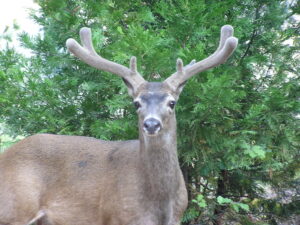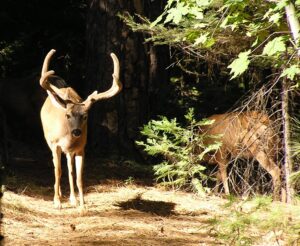By John Buckley, Executive Director

A small buck with antlers covered with velvet
Because our three-acre property and our home outside of Twain Harte are at the edge of the national forest, we are fortunate to share our neighborhood with a wide diversity of wildlife species. In recent weeks a game camera only 150’ from our front porch got photos of a coyote, squirrels, deer, a mama bear and cub, and a mountain lion. We have bobcats and gray foxes pass through our yard in the bright sunshine of daytime, and opossum and flying squirrels often get photographed by the game camera at night.
Besides many bird species, chickarees and gray squirrels are the most abundant wildlife in our neighborhood, but deer are also present nearly every day. Throughout this summer we’ve seen multiple does and yearlings, plus we have a doe with one fawn and another doe that has two fawns. Our neighbor just reported seeing a doe with three fawns, so we are never surprised to see mountain lions photographed by our game camera as they prowl through the forest in their search for deer and other prey.
Many of the wildlife species have grown accustomed to my wife and me being out in the yard. I can be noisily splitting firewood, only to be startled by a doe that casually walks by 30 or 40 feet away. The doe with one fawn seems to feel especially safe with humans nearby (perhaps we potentially discourage the threat of an attack by a mountain lion or coyotes), and she often walks nonchalantly with her fawn right across the yard below our front deck as if we are just part of the habitat.
The bucks in our overall area are far more cautious. They keep their distance down the slope through the trees, but as long as we go about our yardwork or simply sit and watch them, they don’t usually spook or bound away.
I spend a lot of time doing projects, chores, and simply exploring in the forest around our home. And the wildlife neighbors always seem to be a precious part of our local mini-ecosystem.
Today I knew my son was dropping by to visit, so when he came to the front screen door, I waved him in. Instead, I heard him say: “Did you know you have a dead buck right there by the end of the steps?”
I quickly went outside and was stunned to see a very large buck lying on the ground amidst the landscaping right next to the deck. At first I half-expected him to stand up and run off, but I quickly realized he was dead. He hadn’t been there two hours earlier, so it was an immediate mystery how the buck had ended up at this spot. The buck's antlers were still fully covered with velvet, which when seen up close was both beautiful and intriguing.
While my wife talked with my son, I began the process of contacting Animal Control, which led to eventually communicating with State Fish and Wildlife. Over the phone, a wildlife agent took my report and agreed to have someone come deal with the dead buck. By the time the agent arrived, I had looked closely enough at the buck to see at least three holes in the buck’s body – which seemed to be clear evidence that he’d been shot.
The Fish and Wildlife agent agreed that the three holes indicated he’d been poached. Deer rifle season was still a week away, so no hunter should have been shooting at the buck. Somehow, with at least two bullets piercing his body (one of the holes might have been an exit hole), the buck had managed to elude his killer, only to stumble through the forest and across our property until he collapsed and died next to our front deck.
As I helped the Fish and Wildlife agent load the buck into his truck, the agent shared that he was amazed at how big the buck was. He believed it was one of the largest bucks he’d seen – lamenting that its life had been cut short without any use being made of it.
After he left, I stood for a long time in our forest yard and thought about the buck. As the director for CSERC, I take no position on legal hunting despite the fact that I personally don’t eat meat and try to avoid anything that harms animals. Recognizing that others have different values and that some may have a family background of hunting as a heritage, I’ve tried not to be judgmental about hunters.
But seeing the big buck shot illegally led me to question whether making an animal suffer – even done legally as “sport” – is ethical and necessary in this day and age when stores are crammed full of every imaginable food and when there is no true need to hunt – at least here in California. Like many political positions or social views that can have a very wide range of extremes, our Center has consistently strived to aim for protecting the environment without judging those who hold different perspectives on conservation matters.
Today, however, the killing of the buck motivated me to be aware that this coming Saturday, many thousands of hunters will pour into the forests of our mountain region with a passionate desire to shoot a deer. Hundreds of bucks will suffer the same fate as the one that made it to our steps. Since our society cannot get a majority of politicians to vote to ban assault rifles after school shootings or other massacres, it is pretty obvious that there is no political will to end the practice of hunting and killing deer, bears, squirrels, and other wildlife species. But just because it is a popular activity that is satisfying for large numbers of hunters, doesn’t mean that all of us who are non-hunters should just accept the pain it causes for targeted species. It doesn’t mean that we should collectively just continue to accept hunting as “sport” or that we should avoid describing the pain it causes for animals that have done nothing to deserve being shot.
With this Director's Report, my intent is to share my sadness as I knelt beside the beautiful buck and lamented his suffering and death. I hope that this Report makes you think about the topic, and perhaps consider steps big or small that may reduce the significant impact that humans have on our web of life in this region – including the impact of shooting animals with guns. Is it still really a necessary or desirable activity on public lands of our vast region? Or at some point will our society evolve to a point where animals suffering needlessly for a hunter’s enjoyment is not generally accepted?
John Buckley
Executive Director


